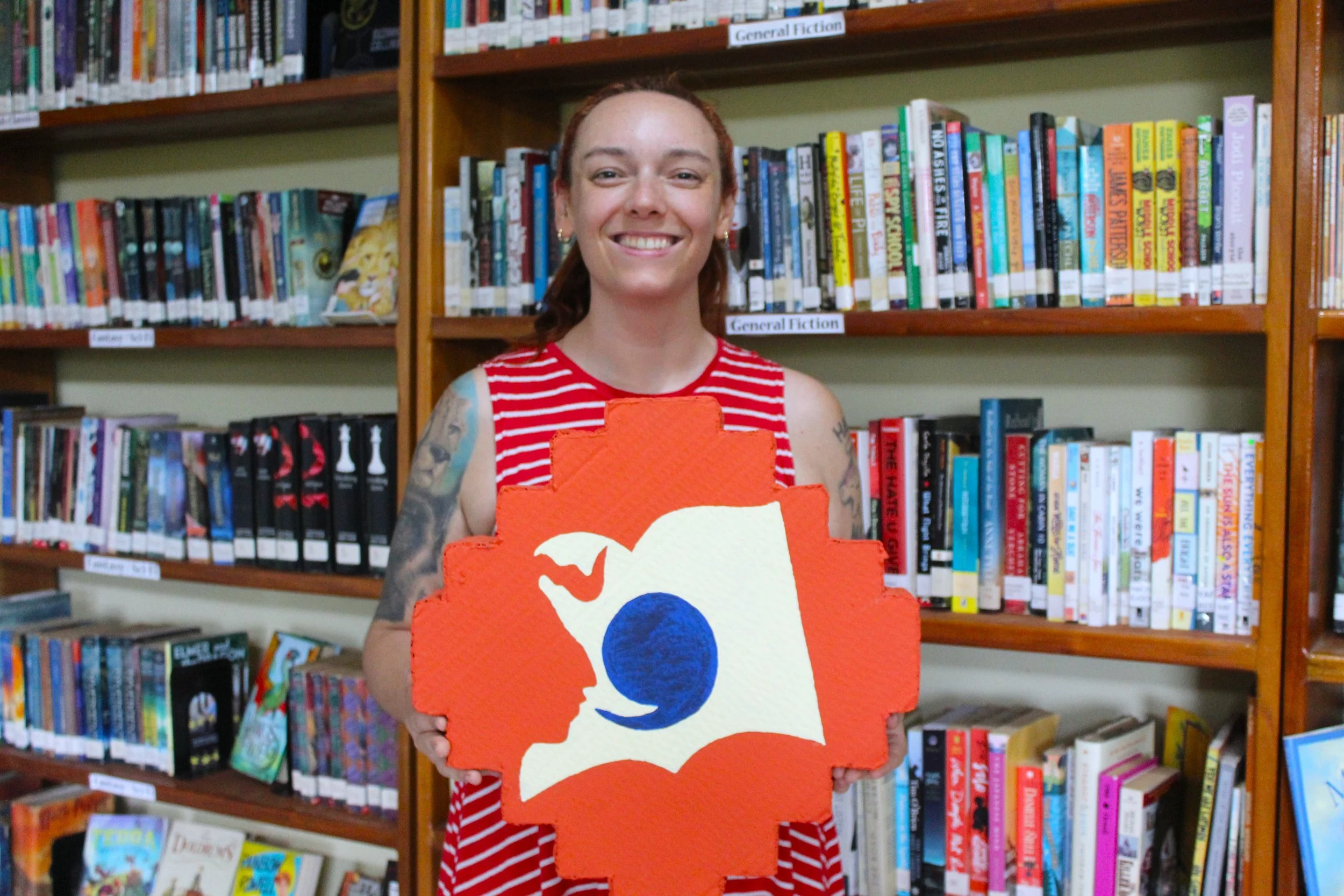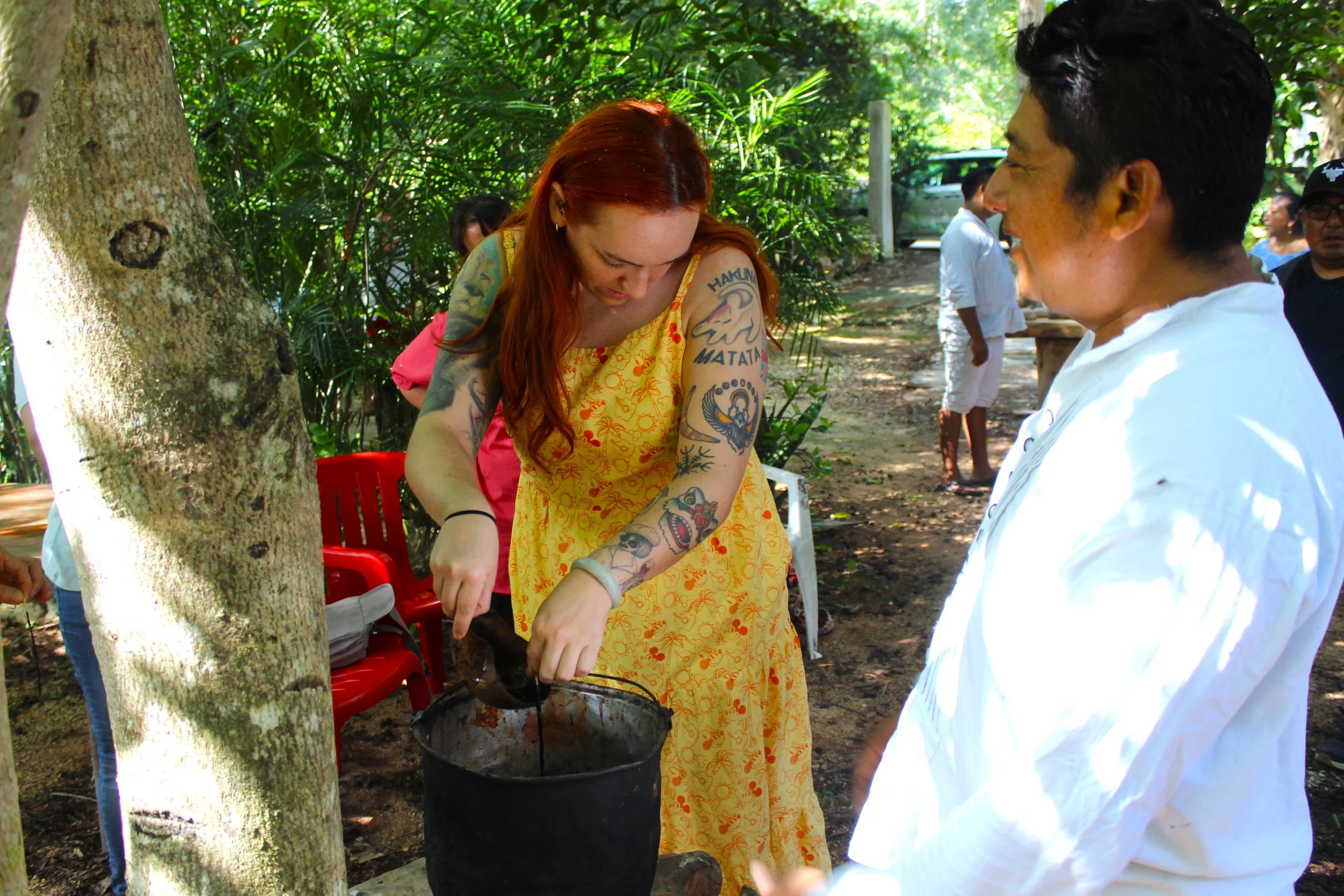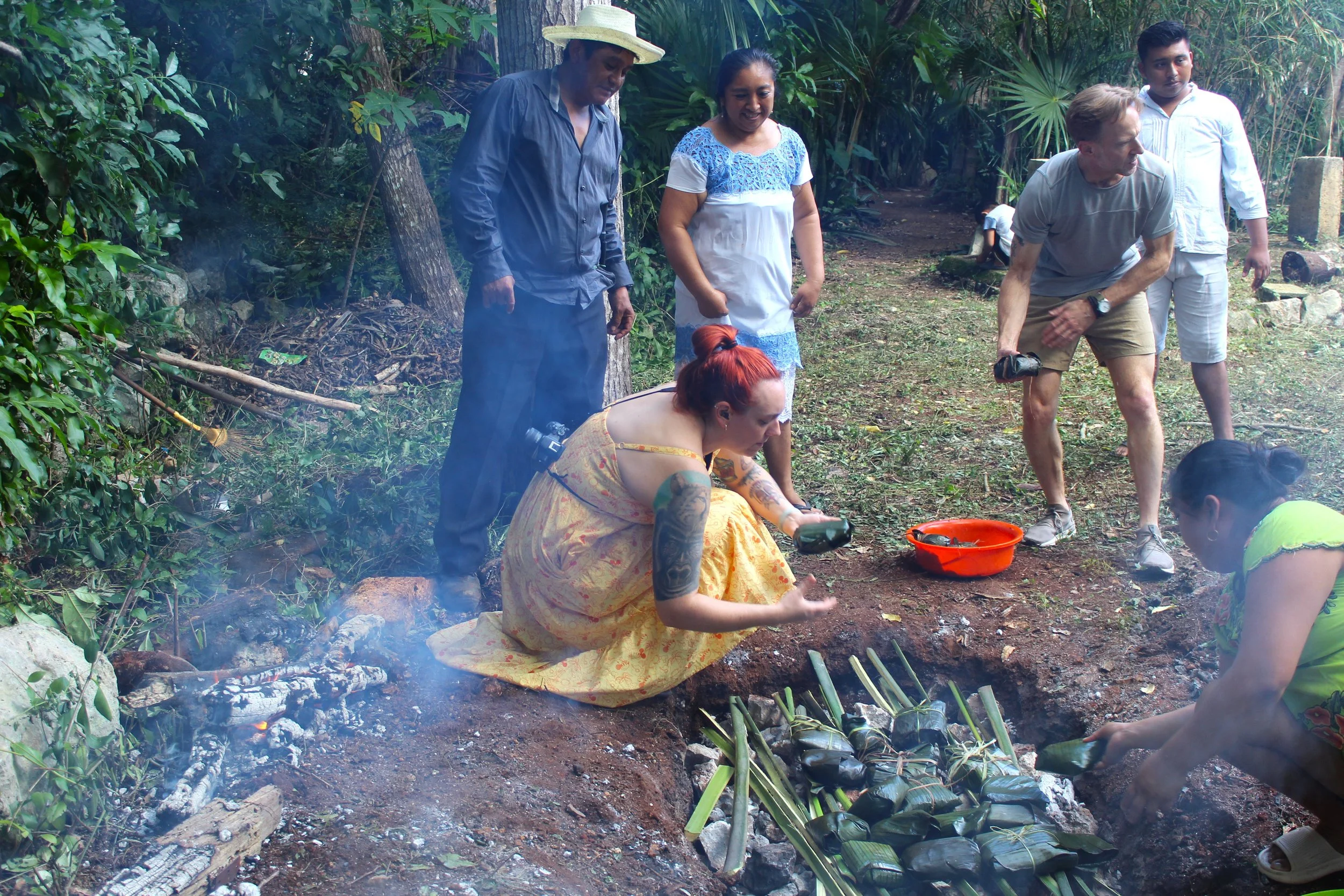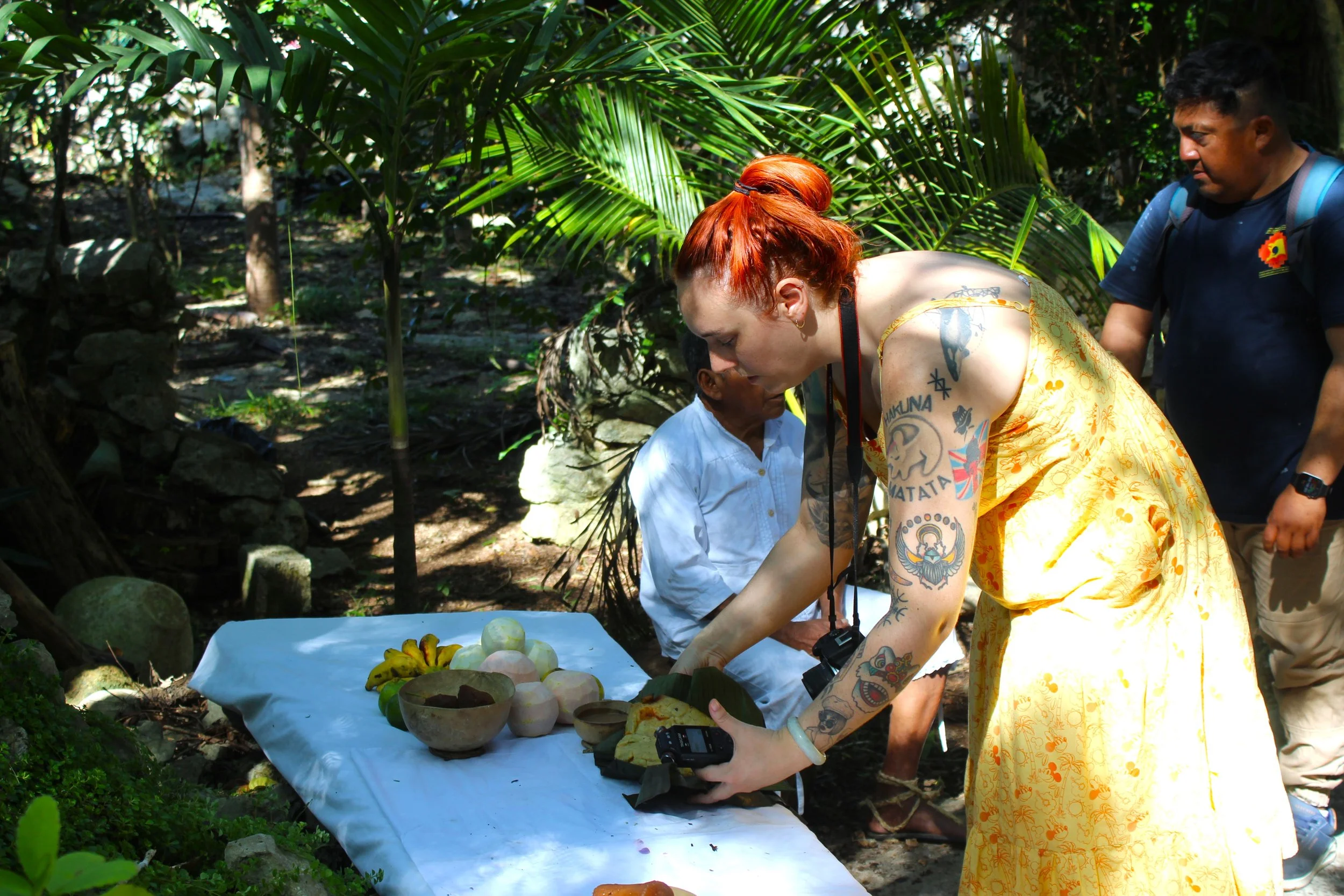Faces of Na'atik: Micki Sievers
Micki joined us during the Janal Pixán celebrations to learn more about this tradition and enrich her research on Mayan culture. We were delighted to see her genuine interest in learning more about Janal Pixán and the respect she always showed to the people at Felipe Carrillo Puerto and to the culture.
“When I saw Na'atik and the Janal Pixán experience, I realized that it sounded a lot more like you would be immersed in it compared to it just being a touristic thing, and that you will be able to experience a lot of things that are not normally in the tourism market.”
What was her experience like, and what did she enjoy most? Let's find out together!
How did you find out about Na'atik and the activities taking place here?
Originally I found Na’atik because I was curious if there were places helping revitalize the Mayan language and help teach people and so Na’atik was pretty much the first and only thing that came up when I looked that specifically like Yucatec Mayan Languages and I saw that they had online programs which were really fantastic and so that was how I first found it. And then later on when I was deciding on my project I was like “oh I remember Na’atik seemed to have something around Día de Muertos and stuff like that and they had Janal Pixán specifically, so I decided to reach out and luckily Dafne was able to talk with me about to potentially coming out here.
How has your experience been staying with your host family so far?
It’s been great. Na’atik put me with a family that is Maya, because they knew that’s what I wanted to study so they felt it would be a good opportunity and I really think it has been like that. My host family is incredibly friendly, I have been able to experience them speaking in Maya when my host mom’s relatives have come over and she is also teaching her children Maya, which is really fantastic so they’ve been really great. They’ve also let me try different dishes that are specifically Maya and things like that, it has been fantastic.
Before coming here, what were your expectations about the city, and how has your impression changed since arriving?
So, I have traveled through this region before so I kind of slightly knew what to expect but I will say that Felipe Carrillo Puerto is a little bit tinier than I expected, it definitely feels a lot more safe. Some cities at night you might not always feel safe to walk around but I felt safe all throughout the town, people are friendly, they also don't bother you if you don't want to be bothered. It feels very comfortable and I also think that is very lively like Na'atik said on their site, it feels like people here are really being Maya and living just a more traditional life comparing to other big cities in Quintana Roo.
What brought you to visit the state of Quintana Roo, and what inspired your interest in learning about the Janal Pixán tradition?
So I had done a preresearch trip last year in 2024, and traveled across Guatemala, Belize and México just seeing if there was a good discussion about Mayan tourism and Maya religion and so originally I came out to this area and saw a lot of different things being kind of sold to tourists and stuff like that. When I saw Na'atik and the Janal Pixán experience, I realized that it sounded a lot more like you would be immersed in it compared to it just being a touristic thing, and that you will be able to experience a lot of things that are not normally in the tourism market and I thought that would be a great reason to come out to this area again and do my actual official research.
How would you describe the atmosphere and the participation of the people during the Janal Pixán celebration?
I would definitely say that amongst the other students that were going there, we were all really excited and were very welcome to different experiences. Especially when we went to Tihosuco that was incredibly great, we all really liked being able to make tamales with the family and learn about the culture in the town and getting really up close and personal with things like that. Most of the activities we were part of for Janal Pixán were very involved and really got you to experience the tradition so I would say it was a very welcoming and open experience.
What was your impression when you saw the decorations and activities?
I thought it was really great, especially the festival that took place here in Felipe Carrillo Puerto on Sunday, it was amazing. For that one, it was cool to be here leading up to the celebration because I got to see them putting things together and see the decorations going up. That was really interesting and the decorations were things that were similar to Día de Muertos, but we were informed that the actual tradition [Janal Pixán] that took place here a lot of which I didn't know. I thought it was really cool to be able to especially make the altar that we did here at Na'atik as well as go to Aniceto's house and see his altar and get to eat the food with him, a lot of it was very informational.
Which part of the celebration did you find most meaningful or interesting?
I think going to Tihosuco was probably the one that was really interesting because it was a nice long day experience. We got to do a bunch of different activities with the family and also went to Aniceto's house and the food was amazing. Learning about the food was really great, so I think that's probably the top parts for me but then I also thought working on the altar together was very emotional and I think it was something that a lot of us connected with seeing who we placed on the altar, I think it created a very loving conversation.
Was there anything that surprised you or that you didn’t know about Janal Pixán before coming here?
Oh yeah, there were definitely some interesting surprises. I especially had never heard of the tradition of leaving bones outside of the house or outside of the altar for the family to come and la Muerte also comes and consume the bones you place, so the more bones you place, the longer your family were going to stay and eat. That was something completely new I have never heard of and they say that's unique to this area so that was really awesome to learn about. Also, like learning about how the altars are different in this region as well, I wasn't aware of the completely different changes which at the festival on Sunday they had displays with different altars and so that was really interesting. As well as being able to make the food was a really nice surprise and learning about the ingredients and the importance of Pan de Muerto and why certain things are done for the Pan de Muerto, I learned a lot of really cool things.
What do you think people from outside Quintana Roo can learn from this tradition?
I think it's a very beautiful tradition, especially in places like the United States I think people are very scared of death and they don't like to talk about it a lot of times, so I think that embracing these traditions is a really beautiful way to have more open discussions about death and acceptance as well as remembering people who has passed. It's overall a really beautiful tradition and I saw that when we were making our altar that a lot of people were really feeling a lot of things that they hadn't really talked about for a while and I think it can really help people in processing the way the that life goes, that it begins and it ends eventually. I think it's something that a lot of people can learn from and impact the way they think about life.
What message would you share with others who haven’t experienced Janal Pixán yet?
I would definitely recommend that they come out here and really appreciate the differences between what Día de Muertos is and Janal Pixán, and appreciate both, but learn about the differences and everything like that. I hope more people will become aware of this tradition because I do think that they are very rooted in your emotions and your connection to the family and they’re more traditionally aligned with those beliefs so I think that coming here and learning about Janal Pixán would give people a deeper understanding than what they think this time of the year is for. Especially in the United States, Día de Muertos is becoming very popular but a lot of people don't actually know what it's about, they just really like the look of it, and I think if people learn more about Janal Pixán it would give them a deeper understanding of what the true purpose of the holiday is about.
I guess I would just like to say that I really enjoyed the time here and I thought that everybody in Na'atik was very friendly and very welcoming. All the staff have great personalities and they seem very excited to come to work everyday and it's like a very healthy learning environment compared to where it could seem like they’re all tired, like the kids don't wanna be here, it seems like people really want to be here and the community also seems to really like Na'atik and have a good connection. Like the Halloween event that they have here at Na'atik was really a fun time, to see all the kids coming out with their outfits and being able to see how much it brought students together.
I really think that especially Na'atik has a good idea of how to create good tourism in Felipe Carrillo Puerto and respect the community a lot, I highly recommend people if they want to learn Spanish this is a great immersion experience in a town that feels very safe and very friendly and everybody have a really good time out here studying. I'm already thinking about the time to come back!
Thanks for talking to us Micki, we hope to have you back with us soon, best of luck with your project!
To learn more about Na’atik’s English language program for local and Indigenous students in Felipe Carrillo Puerto, visit our Impact Page. We are only able to provide this much needed program thanks to the support of generous donors and the funds raised from our award winning Maya and Spanish Immersion Program. If you would like to support our mission please consider donating today or take a look at our immersion programs and online class packages.






